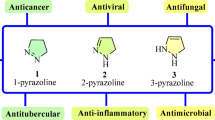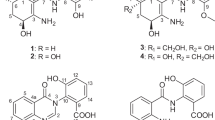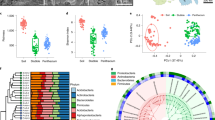Abstract
Three amino acid-derived compounds, haenamindole (1) and 2'-epi-fumiquinazolines C (2) and D (3), were isolated from cultures of a fungicolous isolate of Penicillium lanosum (MYC-1813=NRRL 66231). Compound 1 was also encountered in cultures of P. corylophilum (MYC-418=NRRL 28126). Structure elucidation of these metabolites was based mainly on high resolution mass spectrometry and NMR data analysis. Haenamindole (1) was found to be a recently reported diketopiperazine-type metabolite that incorporates an unusual β-Phe unit. Analysis of X-ray crystallographic data and the products of acid hydrolysis of 1 enabled a conclusive, slightly modified stereochemical assignment for haenamindole. Fumiquinazoline analog 2 is a new natural product, while related compound 3 has been previously reported only as a product of an in vitro enzymatic step and of a genetically engineered fungal culture. Compounds 1 and 3 showed antiinsectan activity against the fall armyworm Spodoptera frugiperda.
Similar content being viewed by others
Log in or create a free account to read this content
Gain free access to this article, as well as selected content from this journal and more on nature.com
or
References
Zhang, Y. et al. Novel antiinsectan oxalicine alkaloids from two undescribed fungicolous Penicillium spp. Org. Lett. 5, 773–776 (2003).
Li, C., Gloer, J. B., Wicklow, D. T. & Dowd, P. F. Thiersinines A and B: novel antiinsectan indole diterpenoids from a new fungicolous Penicillium species (NRRL 28147). Org. Lett. 4, 3095–3098 (2002).
Nelson, T. S., Beasley, J. N., Kirby, L. K., Johnson, Z. B. & Ballam, G. C. Isolation and identification of citrinin produced by Penicillium lanosum. Poult. Sci. 59, 2055–2059 (1980).
Beasley, J. N., Blalock, L. D., Nelson, T. S. & Templeton, G. E. The effect of feeding corn molded with Penicillium lanosum to broiler chicks. Poult. Sci. 59, 708–713 (1980).
Frisvad, J. C. et al. Four psychrotolerant species with high chemical diversity consistently producing cycloaspeptide A, Penicillium jamesonlandense sp. nov., Penicillium ribeum sp. nov., Penicillium soppi, and Penicillium lanosum. Int. J. Syst. Evol. Microbiol. 56, 1427–1437 (2006).
Kim, J. W. et al. Haenamindole, an unusual diketopiperazine derivative from a marine-derived Penicillium sp. KCB12F005. Bioorg. Med. Chem. Lett. 25, 5398–5401 (2015).
Ames, B. D. et al. Complexity generation in fungal peptidyl alkaloid biosynthesis: oxidation of fumiquinazoline A to the heptacyclic hemiaminal fumiquinazoline C by the flavoenzyme Af12070 from Aspergillus fumigatus. Biochemistry 50, 8756–8769 (2011).
Joshi, B. K., Gloer, J. B., Wicklow, D. T. & Dowd, P. F. Sclerotigenin: a new antiinsectan benzodiazepine from the sclerotia of Penicillium sclerotigenum. J. Nat. Prod. 62, 650–652 (1999).
Matsunaga, K., Shizuri, Y., Yamamura, S., Kawai, K. & Furukawa, H. Isolation and structure of citreoindole, a new metabolite of hybrid strain KO 0052 derived from Penicillium citreo-viride B. IFO 6200 and 4692. Tetrahedron Lett. 32, 6883–6884 (1991).
Hirsch, S., Miroz, A., McCarthy, P. & Kashman, Y. Etzionin, a new antifungal metabolite from a red sea tunicate. Tetrahedron Lett. 30, 4291–4294 (1989).
Barrow, C. J. et al. WIN 64821, a new competitive antagonist to substance P, isolated from an Aspergillus species: structure determination and solution conformation. J. Org. Chem 58, 6016–6021 (1993).
Maes, C. M., Potgieter, M. & Steyn, P. S. N.m.r. assignments, conformation, and absolute configuration of ditryptophenaline and model dioxopiperazines. J. Chem. Soc. Perkin Trans. 1, 861–866 (1986).
Kosemura, S., Ogawa, T. & Totsuka, K. Isolation and structure of asterin, a new halogenated cyclic penta-peptide from Aster tataricus. Tetrahedron Lett. 34, 1291–1294 (1993).
Morita, H., Nagashima, S., Takeya, K. & Itokawa, H. Astins A and B, antitumor cyclic pentapeptides from Aster tataricus. Chem. Pharm. Bull. 41, 992–993 (1993).
Morita, H., Nagashima, S., Takeya, K. & Itokawa, H. A novel cyclic pentapeptide with a β-hydroxy-γ-chloroproline from Aster tataricus. Chem. Lett. 23, 2009–2010 (1994).
Morita, H., Nagashima, S., Takeya, K. & Itokawa, H. Cyclic peptides from higher plants. Part 8. Three novel cyclic pentapeptides, astins F, G and H from Aster tataricus. Heterocycles 38, 2247–2252 (1994).
Corbin, J., Marsh, B. H. & Peters, G. A. N-γ-L-glutamyl-β-D-aminophenylpropanoic acid, a dipeptide from the aquatic fern, Azolla caroliniana. Phytochemistry 25, 527–528 (1986).
Needham, J., Kelly, M. T., Ishige, M. & Andersen, R. J. Andrimid and moiramides A-C, metabolites produced in culture by a marine isolate of the bacterium Pseudomonas fluorescens: structure elucidation and biosynthesis. J. Org. Chem 59, 2058–2063 (1994).
Fredenhagen, A. et al. Andrimid, a new peptide antibiotic produced by an intracellular bacterial symbiont isolated from a brown planthopper. J. Am. Chem. Soc. 109, 4409–4441 (1987).
Drandarov, K. Verbacine and verballocine, novel macrocyclic spermine alkaloids from Verbascum pseudonobile Stoj. et Stef. (Scrophulariaceae). Tetrahedron Lett. 36, 617–620 (1995).
Chi, Y.-M., Hashimoto, F., Yan, W.-M. & Nohara, T. Five novel macrocyclic spermine alkaloids from Incarvillea sinensis. Tetrahedron Lett. 38, 2713–2716 (1997).
Cole, R. J. & Cox, R. H. Handbook of Toxic Fungal Metabolites 708–712 (Academic Press, New York, USA, 1981).
Ghosh, A. C. & Ramgopal, M. Cyclic peptides from Penicillium islandicum. A review and a reevaluation of the structure of islanditoxin. J. Heterocyclic Chem. 17, 1809–1812 (1980).
Clardy, J., Springer, J. P., Buechi, G., Matsuo, K. & Wightman, R. Tryptoquivaline and tryptoquivalone, two tremorgenic metabolites of Aspergillus clavatus. J. Am. Chem. Soc. 97, 663–665 (1975).
Takahashi, C. et al. Fumiquinazolines A-G, novel metabolites of a fungus separated from a Pseudolabrus marine fish. J. Chem. Soc. Perkin Trans 1, 2345–2353 (1995).
Snider, B. B. & Zeng, H. Total syntheses of (−)-fumiquinazolines C, E, and H. Org. Lett. 4, 1087–1090 (2002).
Gao, X. et al. Fungal indole alkaloid biosynthesis: genetic and biochemical investigation of the tryptoquialanine pathway in Penicillium aethiopicum. J. Am. Chem. Soc. 133, 2729–2741 (2011).
Dowd, P. F., Berhow, M. A. & Johnson, E. T. Differential activity of multiple saponins against omnivorous insects with varying feeding preferences. J. Chem. Ecol. 37, 443–449 (2011).
Bauer, A. W., Kirby, W. M. M., Sherris, J. C. & Turck, M. Antibiotic susceptibility testing by a standard single disk method. Am. J. Clin. Pathol. 45, 493–496 (1966).
Wagenaar, M. M. & Clardy, J. Dicerandrols, new antibiotic and cytotoxic dimers produced by the fungus Phomopsis longicolla isolated from an endangered mint. J. Nat. Prod. 64, 1006–1009 (2001).
Höller, U., Gloer, J. B. & Wicklow, D. T. Biologically active polyketide metabolites from an undetermined fungicolous hyphomycete resembling Cladosporium. J. Nat. Prod. 65, 876–882 (2002).
Sheldrick, G. M. SADABS v2014/2 semi-empirical absorption and beam correction program. University of Göttingen, Germany.
Spek, A. L. PLATON SQUEEZE: a tool for the calculation of the disordered solvent contribution to the calculated structure factors. Acta Cryst. C 71, 9–18 (2015).
Acknowledgements
We are grateful to Professors Hyuncheol Oh of Wonkwang University and Jae-Hyuk Jang of the Korea Research Institute of Bioscience and Biotechnology (KRIBB) for providing a sample of haenamindole (1), which enabled direct comparison and verification that it was identical to our own sample of 1. We also thank Ms Nicole Krausert for technical support. Financial support was provided in part by a grant from the National Science Foundation (CHE-1011847). Crystallographic data were collected through the SCrALS (Service Crystallography at Advanced Light Source) program at Beamline 11.3.1 at the Advanced Light Source (ALS), Lawrence Berkeley National Laboratory. The ALS is supported by the US Department of Energy, Office of Energy Sciences Materials Sciences Division, under contract DE-AC02-05CH11231. Technical assistance from staff of the University of Iowa NMR and MS facilities is greatly appreciated. The USDA is an equal opportunity provider and employer.
Author information
Authors and Affiliations
Corresponding author
Ethics declarations
Competing interests
The authors declare no conflict of interest.
Additional information
This article is dedicated to the fond memory of the late Professor Lester Mitscher, a great scholar, teacher and Emeritus Editor of The Journal of Antibiotics.
Supplementary Information accompanies the paper on The Journal of Antibiotics website
Supplementary information
Rights and permissions
About this article
Cite this article
Hwang, I., Che, Y., Swenson, D. et al. Haenamindole and fumiquinazoline analogs from a fungicolous isolate of Penicillium lanosum. J Antibiot 69, 631–636 (2016). https://doi.org/10.1038/ja.2016.74
Received:
Revised:
Accepted:
Published:
Issue date:
DOI: https://doi.org/10.1038/ja.2016.74
This article is cited by
-
Non-lipopeptide fungi-derived peptide antibiotics developed since 2000
Biotechnology Letters (2019)
-
A New L-alanine Derivative from the Mangrove Fungus Penicillium chrysogenum V11
Chemistry of Natural Compounds (2018)



